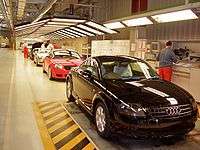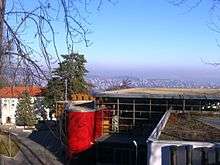Germany–Hungary relations
 | |
Germany |
Hungary |
|---|---|
Germany–Hungary relations are the relations between Germany and Hungary, two member states of the European Union and the NATO. Both countries have a long shared history. Germany has an embassy in Budapest. Hungary has an embassy in Berlin, two general consulates (in Düsseldorf and Münich) and nine honorary consulates (in Bremerhaven, Erfurt, Hamburg, Nürnberg, Schwerin, Dresden, Essen, Frankfurt and Stuttgart).[1] The Agreement between the Federal Republic of Germany and the Republic of Hungary on Friendly Cooperation and Partnership in Europe concluded in 1992 is one of the principal cornerstones of today’s bilateral relations.[2]
Hungary set down an important marker for future bilateral relations on 10 September 1989 when it opened up its border with Austria to refugees from the former German Democratic Republic, thus making a special contribution towards German reunification and the political transformation in Central and Eastern Europe.[2] The 2009 celebrations commemorating those events are symbolic of German–Hungarian relations.[2]
Shared history

Arnulf I of Bavaria maintained an alliance with the Hungarians until his death in 899.[3] During their campaigns following their conquest of the Carpathian Basin the Hungarians stopped neither at the river Morava nor at the western border of Pannonia, but penetrated deeply into the territory of Bavaria as far as the river Enns.[4][5] During the battle of Pressburg[6] on July 4, 907, a Bavarian army was defeated by the Hungarians.[6] The Battle of Lechfeld (10 August 955) was a decisive victory by Otto I the Great, King of the Germans, over the Hungarian leaders. The defeat effectively ended Magyar raids on the West.[7]
Fearing a war of extermination, Géza of Hungary (972-97) assured Otto II that the Hungarians had ceased their raids and asked him to send missionaries.[7] Otto complied, and in 975 Géza and a few of his kinsmen were baptized into the Roman Catholic Church.[7] Géza used German knights and his position as chief of the Hungarians' largest clan to restore strong central authority over the other clans.[7] Hungary's ties with the West were strengthened in 996 when Géza's son, Stephen I of Hungary married Princess Giselle of Bavaria, sister of Emperor Henry II.[7] On the eve of World War I a Munich archaeologist discovered her grave in the church of the Niedernburg convent — which has since become a place of pilgrimage for the Hungarian faithful.[8]
Transylvania was conquered and colonized with — besides Székely people — German Saxons in the eleventh and twelfth centuries.[7] In 1241-42 the Mongols reduced Hungary's towns and villages to ashes and slaughtered half the population.[7] Béla IV of Hungary repopulated the country with a wave of immigrants, transforming royal castles into towns and populating them with Germans, Italians, and Jews.[7] Hungarian kings were keen to settle Germans in the country's uninhabited territories.[8]
Sigismund, Holy Roman Emperor was from 1387 to 1437 also a King of Hungary. Although Hungary's economy continued to flourish, Sigismund's expenses outstripped his income.[7] Social turmoil erupted late in Sigismund's reign as a result of the heavier taxes.[7] Hungary's first peasant revolt was quickly checked, but it prompted Transylvania's Hungarian and German nobles to form the Union of Three Nations, which was an effort to defend their privileges against any power except that of the king.[7]

In the 18th century, under Charles IV and Maria Theresa, Hungary experienced economic decline. Centuries of Ottoman occupation, rebellion, and war had reduced Hungary's population drastically, and large parts of the country's southern half were almost deserted. A labor shortage developed and the Habsburgs called among others German peasants to Hungary.[7]
During World War I both countries were Central Powers, while during World War II the two were allies culminating in the German occupation of Hungary.
Hungary's 1989 decision to open its borders with Austria to help East German refugees flee to West Germany was a key factor in preparing for the German reunification.
Economic relations
Germany is Hungary's most important foreign trade partner, both as a customer and as a supplier.[9] Germany is one of the countries with which Hungary has a trade balance surplus.[2]
German aid to Hungary between 1990 and 1995 totaled DM 5 billion, loans and aid reflected privileged treatment of Hungary in the region.[10]
Germany is also the leading foreign investor in Hungary: at the end of 2005, German companies accounted for some 28 per cent of all foreign direct investments in Hungary.[2] In 2005 alone, Germany invested or reinvested some EUR 1.2 billion in Hungary.[2] There are more than 7,000 companies in Hungary set up partially or wholly with German capital.[2] One of the most important business links is the German-Hungarian Chamber of Commerce and Industry in Budapest representing the interests of more than 900 member companies from both countries.[2] The overwhelming majority (75 per cent) of German investors have been very happy with their involvement in Hungary and would invest there again today, shown by an economic survey conducted by the Chamber.[2]

Audi has built the largest engine manufacturing plant of Europe (third largest in the world) in Győr becoming Hungary's largest exporter with total investments reaching over € 3,300 million until 2007.[11] Audi's workforce assembles the Audi TT, the Audi TT Roadster and the A3 Cabriolet in Hungary.[11] The plant delivers engines to carmakers Volkswagen, Skoda, Seat and also to Lamborghini.[11]
Daimler-Benz invests € 800 million ($1.2 billion) and creates up to 2,500 jobs at a new assembly plant in Kecskemét, Hungary[12] with capacity for producing 100,000 Mercedes-Benz compact cars a year.[13]
Opel produced 80,000 Astra and 4,000 Vectra cars from March 1992 until 1998 in Szentgotthárd, Hungary.[14] Today, the plant produces about half million engines and cylinder heads a year.[14]
Automotive research
Leading automotive manufacturers, including Audi, Bosch, Knorr-Bremse, and ThyssenKrupp have established R&D centers in Hungary:[11]
- Audi – Győr: engine development
- Bosch – Miskolc: electronic hand-tools designing
- Bosch – Budapest: electronic developments
- Continental Teves – Veszprém: development of electronics instruments for cars
- DHS Dräxlmaier – Érd: vehicle compartment designing
- EDAG – Győr: vehicle subunit development
- Knorr-Bremse – Budapest: electronic brake-system development
- Continental Temic – Budapest: car electronics development
- ThyssenKrupp – Budapest: electronic steering development
- WET – Pilisszentiván: electronic subunit development
Cultural relations

Germany and Hungary are closely cooperating in culture and education.[2][15] The goal is the promotion of the German language, academic and school exchanges and cultural events.[2]
The German language plays an important role in the education and economic sectors of Hungary.[2] The Goethe Institute (GI) in Budapest[15] — that has celebrated its 20th anniversary in 2008 — offers a comprehensive range of courses and close cooperation with schools in Hungary.[2] There are also numerous programs designed to promote the German language among Hungary's ethnic German minority.[2] In Budapest, the Thomas Mann Grammar School founded in 1992 is an international school also attended by Hungarians.[2] The German Abitur and the Hungarian university entrance examination may be completed at the Ungarndeutsches Bildungszentrum (Education Centre for Ethnic Germans in Hungary) in Baja.[2]
Hungarian literature is popular in Germany with the works of Péter Esterházy, Péter Nádas, Sándor Márai, Antal Szerb and Imre Kertész achieving the greatest success.[15]
The Collegium Hungaricum in Berlin was founded in 1924.[16] After 1945 it ceased operations, and was reopened in 1973, from 2000 under the old name.[16]
Academic level education
Every year, thousands of Hungarians travel to Germany on study and research exchanges.[2] The German Academic Exchange Service (DAAD) and the Robert Bosch Foundation are awarding scholarships for these.[2]
The Andrássy Gyula German Language University of Budapest plays a key role in German foreign cultural and education policy in Hungary.[2]
Education

There is a German international school in Budapest, Thomas Mann Gymnasium.
See also
References
- ↑ "Ungarische Missionen in Deutschland". Hungarian Embassy in Berlin (in German and Hungarian). Archived from the original on 2010-12-31.
- 1 2 3 4 5 6 7 8 9 10 11 12 13 14 15 16 17 18 19 "Bilateral relations - Hungary". German Foreign Ministry. Retrieved 14 December 2009.
- ↑ Engel, Pál; Andrew Ayton; Tamás Pálosfalvi (2005). Andrew Ayton, ed. The realm of St. Stephen: a history of medieval Hungary, 895-1526. I.B.Tauris. p. 12.
- ↑ Kristó, Gyula (1996). Hungarian History in the Ninth Century (in Hungarian). Szeged: Szegedi Középkorász Műhely. p. 229. ISBN 963-482-113-8.
- ↑ Bóna, István (2000). A magyarok és Európa a 9-10. században ("The Hungarians and Europe in the 9th-10th centuries") (in Hungarian). Budapest: História - MTA Történettudományi Intézete. pp. 28–29. ISBN 963-8312-67-X.
- 1 2 "Bavaria". Encyclopædia Britannica. Encyclopædia Britannica, Inc. 2008.
- 1 2 3 4 5 6 7 8 9 10 11 12 "A Country Study: Hungary". Federal Research Division, Library of Congress. Retrieved 14 December 2009.
- 1 2 Lendvai, Paul (2003). The Hungarians: a thousand years of victory in defeat. C. Hurst & Co. Publishers. pp. 38–39. ISBN 978-1-85065-673-9.
- ↑ "Foreign trade". Hungarian Investment and Trade Development Agency. Retrieved 17 December 2009.
- ↑ Philips, Ann L. (2000). Power and influence after the Cold War. Rowman & Littlefield. p. 104. ISBN 978-0-8476-9523-2.
- 1 2 3 4 "The automotive industry in Hungary - Engine of growth". The Hungarian Investment and Trade Development Agency. Archived from the original on 13 July 2011. Retrieved 27 December 2009.
- ↑ "Germany: Daimler Selects Plant Site". The New York Times. The New York Times Company. 2008-06-19. Retrieved 27 December 2009.
- ↑ Koranyi, Balazs; Erica Billingham (2008-10-27). "Daimler sticks to Hungary investment despite crisis". Reuters. Retrieved 27 December 2009.
- 1 2 "15 éves az első magyar Opel". General Motors Corporation (in Hungarian). 2007-03-08. Archived from the original on 5 January 2010. Retrieved 2 January 2010.
- 1 2 3 "Kultúra, tudomány, oktatás". Hungarian Embassy in Berlin (in German and Hungarian). Archived from the original on 2007-09-23.
- 1 2 "Collegium Hungaricum Berlin - Magyar Kulturális Intézet". Collegium Hungaricum (in German and Hungarian). Archived from the original on 5 April 2010. Retrieved 2 January 2010.

